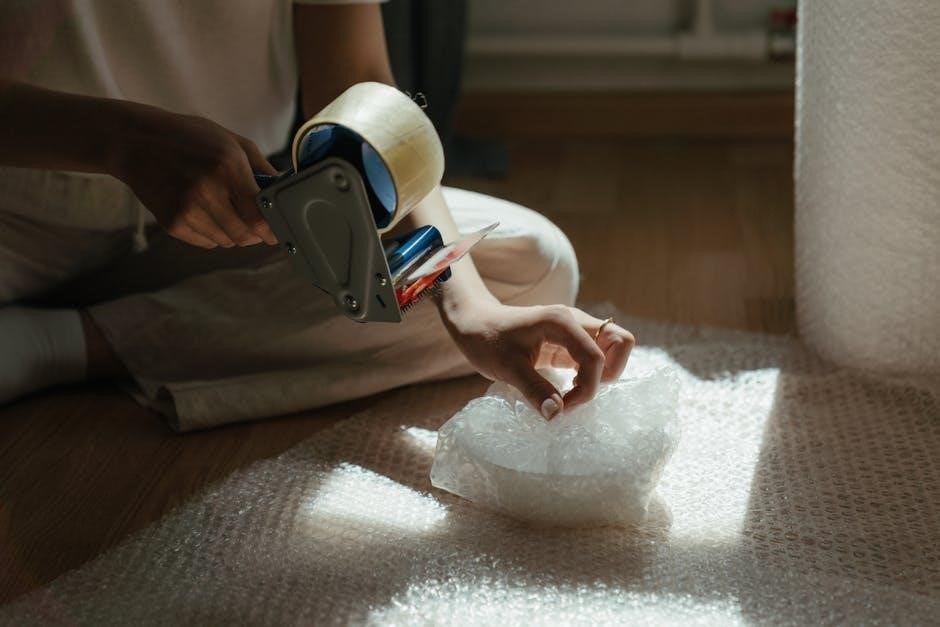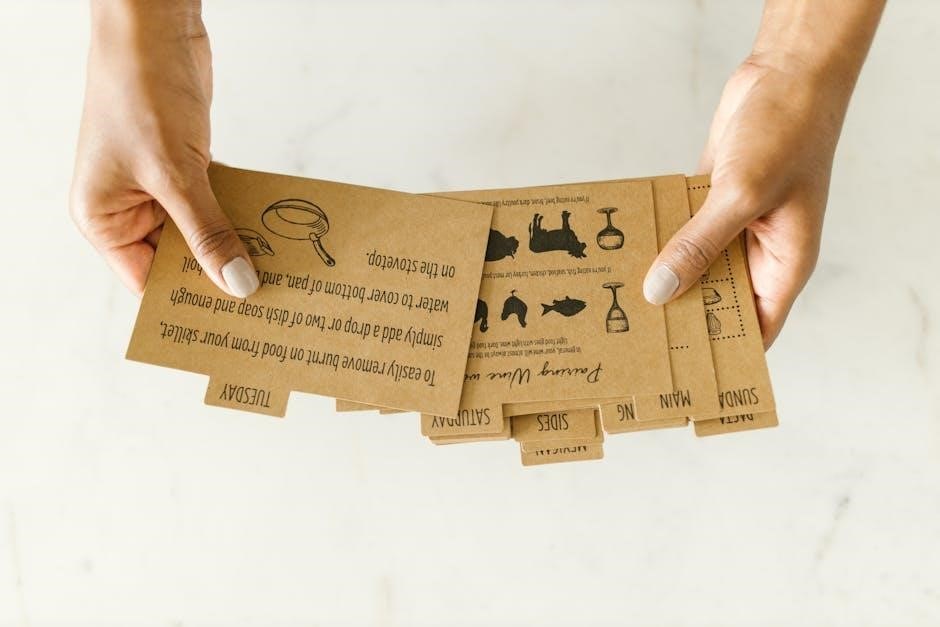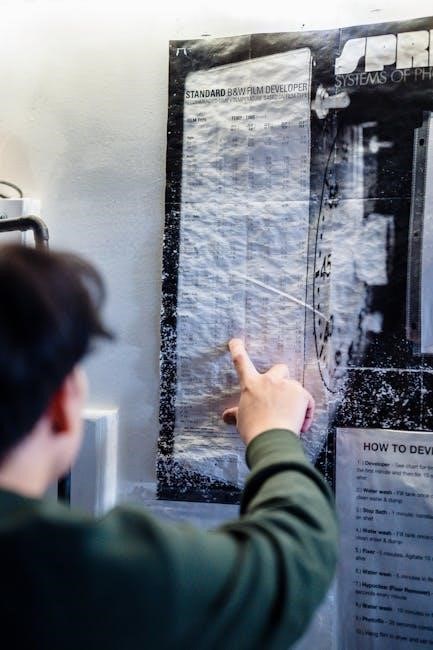Velcro Swaddle Instructions: A Comprehensive Guide
This guide provides comprehensive instructions for using velcro swaddles, designed for easy use and adaptable comfort. Velcro swaddles securely wrap around your baby, offering a snug, comforting embrace that mimics the womb’s coziness. Follow these steps to ensure safe and effective swaddling.
Understanding Velcro Swaddles
Velcro swaddles have become a popular choice for parents seeking a convenient and secure way to swaddle their babies. Unlike traditional swaddling blankets that require specific folding techniques, velcro swaddles offer a simpler approach, making it easier for caregivers to achieve a snug and consistent wrap every time. These swaddles typically feature a shaped design with velcro closures that allow for adjustable tightness and a customizable fit.
The primary purpose of a velcro swaddle is to recreate the comforting sensation of being held, which can help soothe infants and promote better sleep. By restricting movement, especially the startle reflex (Moro reflex), these swaddles can prevent babies from waking themselves up prematurely. Moreover, the snug fit can provide a sense of security, mimicking the environment of the womb, which can be particularly beneficial during the first few months of life.
Velcro swaddles come in various designs and materials, each with its own set of features. Some include leg pouches, while others have adjustable wings that wrap around the baby’s torso. It’s important to choose a swaddle that fits your baby’s size and developmental stage appropriately. Always ensure that the swaddle allows for hip movement to prevent any potential issues with hip development.
Benefits of Using a Velcro Swaddle
Velcro swaddles offer numerous benefits for both babies and parents. One of the most significant advantages is their ease of use. Unlike traditional blankets that require intricate folding, velcro swaddles simplify the swaddling process with straightforward closures. This makes it easier for parents, especially those new to swaddling, to achieve a secure and snug fit quickly. The adjustable velcro straps allow for a customized fit, ensuring the baby is comfortable and secure without being overly restricted.
Another key benefit is the promotion of better sleep. By mimicking the secure feeling of the womb, velcro swaddles help calm infants and reduce the startle reflex, which can disrupt sleep. This leads to longer and more restful sleep periods for the baby, which in turn can improve the overall well-being of both the baby and the parents. A well-rested baby is generally happier and less fussy, making for a more harmonious household.
Moreover, velcro swaddles can contribute to safer sleep practices. When used correctly, they help keep babies on their backs, reducing the risk of Sudden Infant Death Syndrome (SIDS). The snug fit prevents the baby from rolling over onto their stomach, which is a known risk factor for SIDS. The consistent and secure wrap also prevents loose blankets from covering the baby’s face, further minimizing potential hazards.

Step-by-Step Instructions for Using a Velcro Swaddle
Using a velcro swaddle is a simple process designed to provide a snug and secure fit for your baby. Start by laying the swaddle flat on a safe surface, such as a changing table or bed. Ensure that the velcro straps are open and ready to be fastened.
Next, gently position your baby on the swaddle, aligning their shoulders with the top edge. Make sure their legs are inside the designated leg pouch, if the swaddle has one. This helps keep their lower body comfortable and prevents the swaddle from riding up.
Now, take one side of the swaddle and wrap it snugly across your baby’s torso, securing it with the corresponding velcro strap. Ensure that the wrap is firm but not too tight, allowing enough room for comfortable breathing and movement. Repeat this step with the other side of the swaddle, wrapping it across your baby’s torso and securing it with the velcro strap.
Check that the swaddle is snug around the chest and arms, preventing the baby from wiggling free. However, ensure there’s enough room for hip movement to avoid developmental issues. Once secured, double-check all velcro closures to ensure they are firmly attached.
Finally, observe your baby for any signs of discomfort, such as overheating or restricted breathing. Adjust the swaddle as needed to ensure a comfortable and safe fit.
Step 1: Preparing the Swaddle

Before you begin swaddling your baby, it’s crucial to prepare the velcro swaddle correctly. This initial step ensures that the swaddling process is smooth, safe, and comfortable for your little one. First, find a clean, flat surface where you can lay out the swaddle. A changing table, bed, or even a clean floor can work well.
Next, unfold the velcro swaddle completely. Most velcro swaddles are designed in a T-shape or have wings that can be opened up. Ensure that all velcro straps or closures are open and easily accessible. This will make it easier to secure the swaddle once your baby is in place.

Check the swaddle for any potential hazards, such as loose threads, damaged velcro, or rough edges. These could irritate your baby’s delicate skin or pose a safety risk. If you find any issues, address them before proceeding.
Additionally, consider the room temperature. You want your baby to be comfortable, not too hot or too cold. Adjust the baby’s clothing accordingly; A simple onesie is often sufficient, but you might add a light layer if the room is chilly. Preparing the swaddle properly sets the foundation for a safe and effective swaddling experience.
Step 2: Positioning the Baby
Properly positioning your baby within the velcro swaddle is essential for their comfort and safety. Start by gently laying your baby on their back on the prepared swaddle. Ensure that their shoulders are aligned with the top edge of the swaddle when it’s fully opened. This alignment is crucial for a secure and snug fit.
If the swaddle has a leg pouch, carefully place your baby’s legs inside; The pouch should allow for natural movement of the hips and knees, preventing any restriction that could lead to developmental issues. It’s vital to ensure the legs aren’t forced straight down, but rather allowed to frog-leg naturally.
Before securing the arms, consider whether you prefer your baby’s arms to be swaddled in or out. For newborns, swaddling with arms in can help to suppress the Moro reflex (startle reflex), promoting longer and more restful sleep. If you choose to swaddle with arms in, gently bring your baby’s arms down to their sides.
Alternatively, some babies prefer having their hands near their face. In this case, position the arms bent at the elbows with hands near the face. Be mindful of your baby’s preferences and adjust the positioning accordingly.

Step 3: Securing the Swaddle
With your baby correctly positioned, it’s time to secure the velcro swaddle. Begin by taking one side of the swaddle, usually the left, and gently wrap it over your baby’s torso. Ensure this side is snug but not too tight, allowing room for comfortable breathing and movement. Fasten the velcro closure securely to the corresponding tab, making sure it adheres firmly.
Next, take the other side of the swaddle, the right side, and wrap it over your baby’s torso in the opposite direction. Again, ensure a snug but not overly tight fit. Secure the velcro closure, aligning it with the appropriate tab on the swaddle. The velcro should be firmly attached to prevent the swaddle from coming undone during the baby’s movements.
Check that both sides are evenly secured, providing balanced pressure around your baby’s body. Adjust the tightness as needed, always prioritizing comfort and safety. The swaddle should feel secure but not restrictive, allowing for gentle chest expansion during breathing.
Once you’ve secured both sides, double-check that all velcro closures are properly fastened. A loose swaddle can pose a safety hazard, so take a moment to ensure everything is securely in place.
Ensuring a Safe and Snug Fit
Achieving a safe and snug fit with a velcro swaddle is crucial for your baby’s comfort and well-being. After securing the swaddle, assess the tightness around your baby’s chest. You should be able to comfortably place two or three fingers between the swaddle and your baby’s chest, ensuring they can breathe freely. Avoid wrapping too tightly, which can restrict breathing and movement.
Check the hip area to ensure your baby’s legs can move freely. The swaddle should not restrict hip movement, as this can lead to hip dysplasia. A healthy swaddle allows the baby to bend their legs up and out at the hips.
Regularly monitor your baby while swaddled, especially during the first few uses. Look for signs of overheating, such as sweating or flushed skin. Adjust the swaddle or clothing underneath if necessary to maintain a comfortable temperature.
Ensure the velcro closures are securely fastened to prevent the swaddle from coming undone. Loose fabric can be a safety hazard. Always place your baby on their back to sleep, as recommended by safe sleep guidelines.
As your baby grows, adjust the swaddle accordingly. Some velcro swaddles have adjustable features to accommodate growth. Discontinue swaddling when your baby shows signs of rolling over, usually around two months, to prevent potential safety risks.
Velcro Swaddle Variations and Brands
The market offers a variety of velcro swaddles, each with unique features and designs. Some variations include adjustable wings, allowing you to customize the snugness around your baby’s arms. Others feature leg pouches to keep the baby’s legs in a comfortable position, promoting healthy hip development. Certain brands incorporate breathable fabrics like cotton or muslin to prevent overheating.
Popular brands include SwaddleMe, known for their easy-to-use designs and adjustable velcro closures. Halo SleepSack Swaddles are another favorite, featuring a two-way zipper for convenient diaper changes. Love to Dream swaddles allow the baby to sleep with their arms up, which some babies find more comfortable.
When choosing a velcro swaddle, consider the size, material, and adjustability. Read reviews to understand other parents’ experiences with different brands and variations. Look for swaddles that are easy to clean and maintain, as babies can be messy.
Some swaddles also come with additional features like pacifier loops or built-in temperature monitoring. Evaluate your needs and preferences to select the best velcro swaddle for your baby. Remember to always prioritize safety and ensure the swaddle meets safety standards.
Tips for Safe Swaddling Practices
Safe swaddling is crucial for your baby’s well-being. Always ensure the swaddle isn’t too tight, allowing room for hip movement to prevent hip dysplasia. The baby’s legs should be able to bend up and out at the hips. Avoid swaddling too tightly around the chest, as this can restrict breathing.
Place your baby on their back to sleep, as recommended by safe sleep guidelines, every time. Never place a swaddled baby on their stomach or side. Discontinue swaddling once your baby shows signs of rolling over, usually around 2-3 months, as they need their arms free to push themselves up.
Monitor your baby for signs of overheating, such as sweating, flushed skin, or rapid breathing. Dress the baby lightly under the swaddle, especially in warmer temperatures. Ensure the room is at a comfortable temperature.
Regularly check the velcro closures to ensure they are secure and not coming loose. Loose velcro can pose a choking hazard. Always follow the manufacturer’s instructions for proper use and care of the swaddle. If you have any concerns or questions, consult with your pediatrician. Swaddling should be a comforting, not constricting, experience for your baby.


